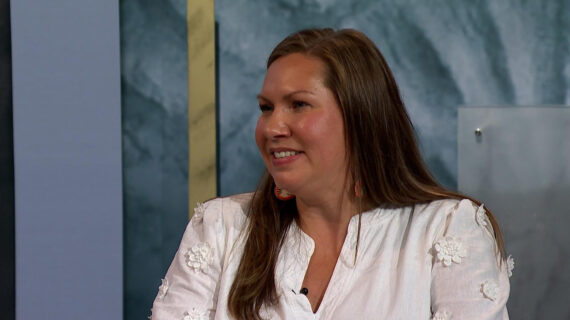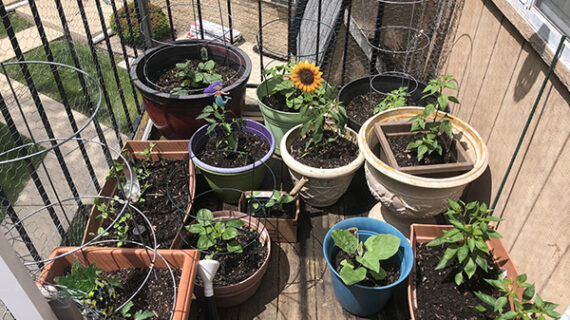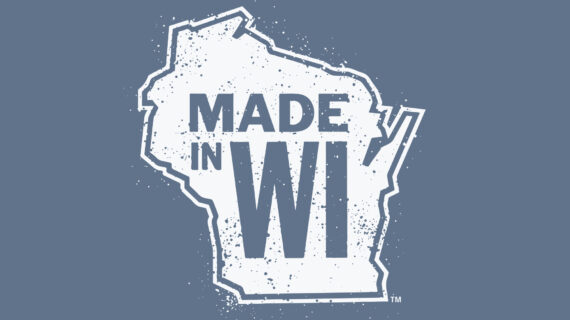– Welcome, everyone, to Wednesday Nite @ the Lab. I’m Tom Zinnen, I work here at UW-Madison Biotechnology Center. I also work for the Division of Extension here at UW-Madison, formerly the Cooperative Extension folks. On behalf of those folks and our co-organizers, Wisconsin Public Television, Wisconsin Alumni Association, and UW-Madison Science Alliance, thanks again for coming to Wednesday Nite @ the Lab. We do this every Wednesday night 50 times a year. Tonight, it’s my pleasure to welcome back to Wednesday Nite @ the Lab Kevin Masarik. He’s at UW-Stevens Point in the Center for Watershed Science and Education in the College of Natural Resources at Point. He’s also a colleague of mine in the Extension here with the Division of Extension at UW-Madison. He was born in Milwaukee and went to Thomas More High School there. And then he went to UW-Stevens Point for his undergraduate degree and studied water resources. Then he came UW-Madison to get master’s in soil science. Tonight, he’s going to be talking about something very appropriate since this is the year of clean drinking water, private wells in Wisconsin. There is very few things having lived on a farmstead, I should say, for a few years, it’s good to know what’s coming up out of the ground and out of your faucet. I’m looking forward to hearing what Kevin has to say tonight as he talks with us about private wells in Wisconsin. Please join me in welcoming Kevin Masarik back to Wednesday Nite @ the Lab.
(audience clapping)
– I appreciate the opportunity to be here tonight. A lot of the presentation today will focus on my experiences traveling the state, talking to well owners about water quality. Extension has this great program where we help communities organize group testing opportunities. For those on private wells, they submit samples to us. We run those samples, I travel back to that community, and I give a presentation very similar to tonight, helping them understand what their test results mean and helping them understand a little bit about water quality where they live. I’ve never got the opportunity to do this at kind of a statewide level or provide a statewide perspective on this issue. So, this is a great opportunity for me to do that, especially given that it’s the year of clean drinking water.
If I highlight what I’m going to cover briefly, the things I want to cover is helping people understand if you have a well, or maybe you don’t have a well, but you rely on a municipal well where that well water comes from. There’s a lot of misunderstandings about ground water and where people’s water comes from. I hope to clarify some of those things today. I’ll highlight the role of well construction in helping understand where people’s water comes from. We’ll highlight some common water quality problems, some of which might be important from a health standpoint. A lot of the complaints that I hear from people might actually not be a health concern, but might be related to the taste, the color, or the odor of the water. So, we’ll talk about some of those issue. Where these problems occur and why they occur is something else we’ll also try to touch upon. And then scattered throughout the presentation, if there are issues, one of the other things we like to do is help people understand if there is a problem that oftentimes there are very simple solutions. So, what are those solutions that people have at their disposal to improve their water quality?
Just getting back to the basics here, where does well water come from? Well water is simply ground water. When it rains or the snow melts, some of that water is going to soak down into the ground eventually reaching a point where all the empty spaces in the rocks or all the cracks in the rock or the space in-between the soil are filled with water. The top of our ground water is basically that water table. Everything below the water table means that all the empty spaces in the soil or rock are filled with water. That ground water is always moving slowly, oftentimes through the empty spaces in the soil or rock to a nearby lake, river, stream, or wetland. We use wells as that access point to that groundwater resource. Those wells provide an opportunity for us to bring that water, bring that groundwater up out of the ground into our homes. Wells also provide a convenient opportunity for us to understand and measure that water quality. Really, it’s these wells that are the window into our water. People’s private wells, because there are so many in Wisconsin, really help us paint the picture of groundwater quality throughout the state.
You’ll hear groundwater scientists talk a lot about aquifers or we talk a lot about geology. In geology, it’s absolutely critical for understanding things like how quickly groundwater moves or how quickly groundwater becomes contaminated. So, the different aquifers, we see a nice picture from the Wisconsin Geological and Natural History Survey showing that Wisconsin’s geology is like a layered cake. The lowermost layer that we’d find if we dug a hole deep enough anywhere in the state of Wisconsin, we’d eventually hit a bedrock unit, which we call crystalline bedrock. Think of your granite countertop at home. If you spill water on that granite countertop, it’s not really going to go anywhere. It’s not sinking into that material. So, we know granite doesn’t hold or store a lot of water. That’s not a very prolific aquifer in Wisconsin. Wisconsin’s groundwater sits in those geologic layers that occur on top of that crystalline bedrock. So, it might be in southern Wisconsin here. It might be alternating layers of sandstones and dolomites. In eastern Wisconsin, it might be coming from what we call the Silurian dolomite aquifer. In most of Wisconsin, with the exception of the southwest region, that groundwater could sit in sand and gravels that were deposited when the glaciers receded. So, where you are in the state is really going to determine what aquifers are at your disposal for accessing groundwater or having water for your private well.
If we look at those diagrams of the different rock types, what I’d mentioned is that water moving through sand or small space in-between sand grains is going to move much more slowly than water moving through large cracks or fissures in various rocks. If the water can move to those materials easily, that means contaminants also are typically going to move through those materials rather rapidly as well, because those cracks or those fissures don’t offer a lot of ability for that water to be filtered as it moves to that material. So, the geology is really critical for helping us understand things like groundwater susceptibility. The different rock materials are also going to impart different chemical characteristics to that water, which we’ll talk about or highlight as well.
When we talk about wells, typical groundwater accessed by private wells is on the order of probably years or maybe decades old. Most private wells are not accessing water that recharged when the glaciers melted. Groundwater, the well water that we access is probably a lot younger than people realize. The closer you are to the top of that aquifer or near the water table, typically the younger that water is going to be. As you drill deeper, you’re typically going to be accessing water that’s older. That might be originating from further away from that well location. I like this diagram because it highlights that anything we do on the land surface does have the potential to impact that water quality below.
I want to highlight the difference between public and private water supplies. Tom highlighted I grew up in Milwaukee. I grew up on a municipal water supply. Those water supplies, I pay a water utility bill that goes to pay a staff that is in charge of managing that water system. Those water utilities are required to regularly test that water. If there’s anything wrong with that water supply, if it exceeds some sort of drinking water standard, they’re required to bring that water up to drinking water standards to make sure that it’s safe to drink for those people that that water is distributed to. That amounts to about 4.1 million people in Wisconsin. The other 1.7 million people rely on private wells. Those are rural wells that people out in the country use to bring water into their homes. There’s about 800,000. That’s the estimate of how many wells exist in the state of Wisconsin. Things to point out about these wells is they’re not required to be regularly tested. There are some testing requirements at the time the well is drilled. They are required to be tested for bacteria. As of 2014, they’re also required to be tested for nitrate. Any time there’s well or pump work done or a well inspection, those wells are required to be tested for bacteria, and as of 2014, nitrate and arsenic. Those are the only times where private wells are required to be tested. Those are the only parameters that they’re required to be tested for. There’s a whole host of other problems that we might experience in our wells that unless you’re taking it upon yourself to do those tests, we might not have a great understanding of. If people do find something wrong with their well water, I think a lot of times the people I talk to are surprised that they’re not required to take any sort of corrective action. That’s one of the reasons why I hear people say they don’t want to test their water ’cause if they find something wrong, they’re scared that they’re going to have to do something to fix it. If we find something wrong with well water through these testing programs, our information is purely educational. We want to give people the tools to take those corrective measures that will help give them safe water, but they’re not required to do that. So, the message I often give people is that if you have a private well, you really are your own water utility manager. It’s up to you to decide what, how often you’re going to test, and if there is anything wrong, what those next steps might be.
When we look at a private well,
typically all we might realize about our private wells, all we might think about is that top 12 to 14 inches that sticks out of the ground. That’s what most people probably think of when they think of their well. It’s important to realize though that there’s a lot happening below that ground surface that we can’t see. We might like to, but it’d be very difficult to understand things like what is that rock or what is that material that that well is drilled into. Without some sort of cam or visual inspection of that area below our feet, a lot of times, we’re using our best guess.
Those best guesses, a lot of times, are based on reports that are filed when that well is constructed by the well driller them self. Every well that’s drilled in the state of Wisconsin is required to have a well construction report filled out at the time of drilling. As of 1988, all new wells also have a Wisconsin unique well number. That’s a unique code that is specific to an individual well. That creates great opportunities for us to do kind of data mining exercises that help us learn and understand Wisconsin’s groundwater. For the people in this room, if you’re curious about things like how deep is my well, how deep did they have to drill before they hit the water table. That metal pipe that sticks out of the ground, how far does it extend below our feet. Those are all really critical pieces of information to know that will help us better understand that private water supply. So, if you’re on a private well, that information is often readily accessible. I’ve created or put the link on here with some information about where people can go if they’re looking to obtain some information about their private well at home. Just know that there’s a lot happening below the ground. Again there’s the casing, there’s submersible pumps, there might be well screens, and then there’s connections that connect up to that well to bring the water into our homes and into our pressure tanks.
So, transitioning into the quality or the private well, water-quality concerns, most people in this room are familiar with the term universal solvent. Water is a polar molecule, which means it’s very good at dissolving things. As much as we all want pure drinking water or pure water, we have to realize that in the natural environment, we never find pure H2O. That groundwater is always going to have impurities depending on the types of rocks or minerals that that groundwater is moving through. It depends on the types of land use where that water infiltrates and soaks down into the ground. It might even depend on the types of plumbing or packaging that that water is stored or transported in. Flint, Michigan really highlighted how plumbing, how the water system itself can impact various water supplies where the source of that lead was not the groundwater, it wasn’t the lake or river where that water was coming from. The source of that lead was the plumbing system. When they changed water supplies, a water supply that was more corrosive or aggressive, it started to peel away or expose a lot of that lead that ended up in people’s homes.
If there are impurities that eventually reach a point where they’re concerned for health, a lot of times, we want to do something about it. I think it’s important to point out that if we do contaminants in our water, there are a lot of variety of ways, treatments being one of ’em, that we can make that water a little bit safer to drink. When we talk about health concerns associated with water, I do think it’s important to point out that there’s two different categories of health concerns associated with water. Some of these are acute effects. Acute effects are those that are seen within a short time of exposure to a particular contaminant or substance. Examples here would be pathogenic organisms, things like E coli, which are associated with foodborne illnesses. We can also see those types of organisms in well water. Those are examples where shortly after being exposed to those organisms, people are going to develop some sort of health complication, usually some sort of gastrointestinal illness, some of which can be quite serious especially for amino-compromised individuals. There’s this other category of health effects which we’d call chronic health effects, which result from exposure to these substances over a long or extended period of time.
Things like arsenic or pesticides that we might find in well water, these are things we know that increase the risk of developing things like cancer. If these things are in somebody’s water, drinking the water once or twice isn’t likely to develop or result in those sort of health consequences. But if we find those things in water, especially if they’re above certain levels, and people are using this water supply for years or decades while they’re in the home, then those people are at an increased risk for health complications later in life. Is it a guarantee that people are going to suffer from those health consequences? Certainly not, but it does mean or is associated with an increased risk. So, if we put that into perspective, I’ve listed a variety of different environmental factors related to various chronic health concerns. I’d point out that there’s a whole host of risk factors for various types of cancers, drinking water, environmental factors being one. But there’s other things like the use of tobacco products, our diet that also have large impacts on whether or not somebody is likely to suffer from these illnesses. But if we put these things into context, we look at something like indoor radon combined with smoking, if there’s 1,000 people that fit that category or that population, we would expect 32 out of 1,000 people to develop lung cancer from those environmental factors and conditions. If we look at water specifically, arsenic is a contaminant with a health standard associated with it. It used to be .050 milligrams per liter or 50 parts per billion. 1,000 people, if they were using a water supply with that level for years or decades, we would anticipate that 13 of those 1,000 would likely develop cancer from that water. So, it’s not a guarantee, but it does come with an increased risk. We can take simple steps a lot of times to reduce those risks. If 13 out of 1,000 is not acceptable, there are simple things that people can do to reduce those risks even further.
When we talk about different categories of well water constituents, there’s a variety. There’s literally hundreds of different tests that people could do on their water supply. I try to limit the amount of tests that people do to those that we know are going to be important either from a health standpoint, so there’s a category that says important to health, those tests that are important because it contributes to taste, color, or odor problems that people often complain about regarding their water. And then there’s other tests that we might do because they’re indicators of overall water quality. They might help us understand things like how corrosive or aggressive is that water going to be. There’s other useful information that we can learn that might not be directly related to health or aesthetic issues associated with well water.
In transitioning to some of the common issues or problems that people have, I’m going to start with coliform bacteria. This is probably the most important test for people on private wells to do on a routine or regular basis. The well code, which the DNR administers, is based on this idea that a properly constructed well should be able to provide bacteria-free water continuously without treatment. That is the one thing that DNR regulates is well construction. They’re trying to get people the best possible chance at getting a bacteriologically free or a sanitary water supply. Coliform bacteria is an indicator test. It’s an indicator of the sanitary condition of that well. Coliform bacteria on their own generally don’t cause illness, but the concern is that if coliform bacteria are getting into that well, it indicates a potential pathway for other harmful organisms to enter that water supply also. Sources of coliform bacteria are soils. They can live in soils or on vegetation. But we can also expect to find them in human or animal waste. That’s why we feel it’s a good indicator of the sanitary integrity of that water system.
If coliform bacteria is detected, if you submit a sample to a lab for bacteria, they’re going to first check for coliform bacteria. If it’s positive for coliform bacteria, they will then check that sample to see if it’s also positive for E. coli.
E. coli, if a well ever comes back positive for E coli, that’s confirmation the source of that bacteria is some sort of human or animal waste source. Obviously that’s a much more serious situation because if human or animal waste is getting into that well, there’s a whole host of other pathogens besides E. coli that we might concerned about, things like salmonella, Campylobacter, Cryptosporidia, or Giardia, would mean if E. coli was present, it would mean that those other pathogens are much more likely to be found in that water supply. Those are things, coliform bacteria again on its own doesn’t necessarily mean that people are going to get sick from that water, but having evidence of these other pathogens would give us some indication that that water supply is probably unsuitable as a drinking water source.
We would be concerned about people being able to fend off those bacteria if this was their primary water supply.
As a rule of thumb, if a well ever comes back positive for E. coli, we generally encourage, strongly encourage those people to stop using the water for drinking and cooking until the problem can be corrected and safe bacteria test is obtained. So, the question I often get when somebody gets a positive bacteria sample is where is that bacteria coming from. These are pictures that I’ve collected over the years from some colleagues. This is the only interactive part of the presentation here. These are all bacteriologically positive wells with the exception of one. Does anybody want to guess what the good well, which the good well is? I see and I’ve heard some people pointing to the left. This is not a trick question.
There’s obvious defects with a lot of those pictures. In the case of the one on the far right, the casing is cracked. Any time it rains, water is falling directly into that well. There’s insects that might be able to crawl into that well. That bottom picture actually shows, it’s a little bit difficult to see, but if you look, there’s actually earwigs crawling around the inside of that casing. If they fall, if they drop into that well, those insects can carry and harbor bacteria in their intestinal tract that would cause or result in positive bacteria samples. There’s a picture in the middle where the dog is kind of chained within a close proximity to that well. If it’s hanging out there all day, it’s probably doing other things there that we shudder to think about if that’s where we’re getting our drinking water from. The types of connections we have: There’s a yard hydrant in that one picture that’s affixed to the top of that well. We also see that there’s a host affixed to it. If that hole doesn’t have proper backflow prevention, any time you shut that yard hydrant off, all the water in that hole potentially will be siphoned back into that well. We know hoses are kind of breeding grounds for bacteria.
We need to make sure that we have proper backflow prevention to ensure that we’re not contaminating our drinking water source. There’s that other picture, which is showing kind of larger tall grass, and there are some white specks on that grass. That’s an area next to the well. This is a person that had a positive E coli sample, but also had a bird feeder directly above their well head.
These are not pictures that I use to make fun of people, they’re pictures that I use to highlight that we don’t always think about where our water comes from. There are very simple things that every well owner can do to make sure that they get the best possible opportunity at getting a sanitary water supply.
As unsightly as that metal pipe looks sticking out of the ground, we generally encourage people to leave that area free and clear. Anything that conceals that well is also going to provide concealment for things like small animals or insects.
Keeping that free and clear also means that if a well driller or pump installer has to come and service that well that they’re not having to move a lot of material, they’re not having to disrupt flowers or shrubs that may have been planted to conceal that well. The grass around that well is probably a little bit green for my liking.
Probably more fertilizer applied on that lawn than I would recommend. But keeping that area pretty well-manicured is probably the best thing that you could do to ensure that you’re giving it the best chance at getting sanitary water.
Other things to look for on your property, there’s a picture of an old dug well. That old dug well, the diagram below, it kind of shows if we keep those holes open, those holes represent direct conduits into the aquifer. So, if it floods or it rains, that water has a direct conduit down into the aquifer where your new well might be pulling its water from. So, if we don’t properly fill and seal those old holes, we might be continuing to contaminate the aquifer that you or your neighbor might be getting their water from. And then I have a picture on the right showing a livestock water.
Without proper backflow prevention, it’s another opportunity for those systems to contaminate wells.
Those are things that are related to well construction. Other reasons why wells might be susceptible to bacterial contamination might be the soils or the geology. I really like this diagram ’cause it shows in areas with very thin soils, those areas might also be more prone to having things like sinkholes.
That water, that surface water is getting into the aquifer rather quickly without adequate filtration. So, in this diagram, we see that empty space or we see that the well.
Basically we have the well depth and then we have the casing. So, those black lines represent the depth of the casing, which in this diagram just extend to the top of that aquifer, which means that that whole bottom section of the well is open to the aquifer. The picture highlights really nicely that water from that sinkhole basically has a direct pathway into that well.
If we extend that casing deeper into the aquifer, that means that we’ve sealed off that upper part of the aquifer and now that water is being pulled from much deeper. It doesn’t mean that that water can’t be contaminated, but we’ve sealed off some of those direct pathways, which means that what happens at the surface, it’s going to be much more difficult for that water from that surface to get down deep into the aquifer where that well is now pulling its water from. So, this diagram I think is important to highlight that while well depth is important, a lot of people talk about how deep their well is, that’s only one component. Well casing is equally as important for determining where within an aquifer somebody is getting their private well water from.
If we look at bacteria occurrence in Wisconsin wells, what we see if we tested all roughly 800,000 private wells in the state of Wisconsin, we’d estimate that at any given time, about 15 to 20% would come back positive. Some of that’s due to well construction. Some of it might be due to geology. Less than 2% of those samples are coming back positive for E. coli. So, having coliform bacteria doesn’t necessarily indicate human or animal waste. However, this would say or show that right around 2% likely do show some evidence that human or animal waste are impacting people’s wells. What we might also notice about the map is that the darker areas are higher likelihoods of having bacteria, the lighter areas are lower risks. Areas where we have very sandy soils like central Wisconsin typically have a lower risk of bacteria in their wells. Sand is typically a great filter, which I think means that there’s maybe less potential for bacteria to get down into the aquifer where people in the central part of the state are pulling their water from.
Anywhere where the positives or the percent exceedance is greater than about 20%, to me, that speaks to some sort of geologic concern, which makes those areas more prone to having bacteria in their wells. If we look at one of those main geologic considerations, it would be areas where we have fractured bedrock, shallow soils overlying that carbonate, cracked, fractured bedrock are areas that we would suspect have a greater potential for this geologic susceptibility or this consideration for bacteria to get into the aquifer without adequate filtration.
So, if people have positive coliforms, what’s the procedure? First, we’d recommend people re-test. If two tests in a row are positive, then the next step is to identify where that positive sample might have resulted from. Correct any sanitary defect, disinfect the well, and then re-test to ensure that that water supply is bacteria-free. For those people that have reoccurring bacteria problems, the best long-term solution might be looking at, can that well be constructed in a better way that would give it a greater likelihood of providing sanitary water. It would be great if wells lasted forever, but the older the well is, chances are, it wasn’t constructed with the same types of materials that we use today. So, as a well ages, typically we might expect more potential for well construction to impact that result as well.
Transitioning into some of the other common complaints that we get are going to be things that are impacted by the rocks or the soils that that water is stored or transported in. Hard water is one of the common complaints that people have. Water hardness results from calcium and magnesium in the different rocks that that groundwater is stored in. Limestone or, in the case of Wisconsin, dolomite rocks contain calcium and magnesium. Water flowing through those rocks is going to dissolve small amounts of calcium and magnesium. We consider water to be hard when it’s greater than about 200 milligrams per liter hardness and that anything less than 150 is considered to be soft water. So, while hard water, some of the issues are going to have are going to be scale depositing on fixtures, maybe in the pipes, on the water heaters. People with hard water tend to go through a lot more detergent or soap because hard water makes it more difficult for that water to form a lather. Those are the typical problems people have that they associate with hard water.
When we look at water hardness in Wisconsin, we know that Wisconsin has in general very hard water. If you’re in eastern Wisconsin, chances are, you have very hard water. Southern Wisconsin, the same thing. As we get into northern Wisconsin, the water, the types of rocks or minerals that that water is stored in don’t contain as much of those elements. So, as we progress into northern Wisconsin, we know that the water tends to be lower in hardness and in some cases even what we would consider to be soft water. It really follows the geology. Those areas where we have carbonate rocks, eastern Wisconsin, southern Wisconsin, and parts of western Wisconsin, correlate really well with those areas where people with wells are dealing with hard water.
If you have hard water, fortunately there’s relatively tried and true technology that helps deal with water hardness. That’s going to be a water softener.
There’s a lot of people in Wisconsin that have water softeners on their wells. These are fairly easy-to-use technologies that remove calcium and magnesium. But what some people might not realize is that in the process of removing those elements, it has to replace it with something else.
That something else is typically going to be sodium, ’cause we use sodium fluoride to regenerate the resin bed of water softeners. With this method, it’s an exchange method. It’s removing the unwanted calcium and magnesium, but it’s adding back in a little bit of sodium. That sodium for most people is not going to be a major concern. But if somebody tells them or somebody’s doctor tells them that I want you to limit your sodium intake, that additional sodium that’s coming from that water softener could be a health consideration that people want to think about.
With water softening, most people will actually bypass their primary drinking water faucet for that reason that they don’t want the additional sodium. But also because a lot of people think that water with calcium and magnesium taste a little bit better. If you ever have drinken reverse osmosis water, a lot of bottled water might be reverse osmosis water, some people complain about the taste. They could taste flat or it doesn’t like anything. That’s because we’ve removed some of those elements like calcium and magnesium. For that reason, sometimes people will bypass their primary drinking water faucet. There’s really no reason to soften the water that you’re using to water the lawn or water your garden. So, bypassing the outer faucet could also save you a lot of money in terms of softener salt.
Transitioning into something else that rock or soil impacts, arsenic is another element of concern in Wisconsin. This is naturally occurring coming from the soils or other geologic materials. We know that areas on the western side of Lake Winnebago can have some of the highest arsenic concentrations anywhere in the world. It’s due to a specific geologic formation. That geologic formation has resulted in special casing areas in that part of the state. Those special casing areas are designed to help people avoid
having their well in contact with that really arsenic-rich layer. By adjusting the casing or adjusting the depth of the well, people are able to easily avoid that layer with the high arsenic. The health standard for arsenic if we look, .010 milligrams per liter or 10 parts per billion is associated with various types of cancer. So, there is incentive for us to reduce exposure to arsenic in our drinking water. Unfortunately there is a couple different treatment options out there for people if they do have elevated levels of arsenic in their water. This map, it’s important to point out that those areas that are blank are just areas where we don’t have sufficient data to be able to say with a lot of confidence what typical levels would be.
Because arsenic is more recent in terms of our recommendations for testing, we just haven’t amassed the same amount of data for some of these constituents. But hopefully through time, we’ll be able to fill in this picture and give people a better indication of the likelihood of encountering arsenic where they live.
Iron is another common complaint. It might be the most common complaint I hear people talk about in regards to their well water. It’s naturally occurring coming from the soils and the rock. Areas where the groundwater is low in oxygen, areas near wetlands or maybe lakes, areas where the soil has a lot of carbon or organic matter tend to have really low oxygen levels. Water that’s low in oxygen has a greater ability to dissolve iron that might occur in the soils or the bedrock. That’s why it’s probably more common for people that live near lakes or in low-lying areas to be experiencing issues with high iron. While there’s no health concerns associated with iron, it does cause some aesthetic issues. That redder, that orange staining might look pretty familiar for people. If you have a well at home or you have lake property, that’s going to be a common sight. Elevated levels of iron also are going to give water that irony or characteristic well water taste. When I hear people talk about not liking the taste of well water, a lot of times I think they’re talking about levels of iron in the water that are giving it kind of a metallic taste. Iron, elevated levels of iron also increase the potential for what we call iron bacteria. That’s a bacteria that if you spend a lot of time in the woods, near lakes or wetlands, you might see kind of an oily sheen on the top of water. I think a lot of people assume that that’s gasoline or oil that might have run off a parking lot. But a lot of times, that might be naturally occurring iron bacteria. That same bacteria can occur in people’s private wells. It gives water kind of an off-putting taste or an off-putting smell. It might tend to clog people’s plumbing system a little bit. So, if people do have high iron, there are treatment options available that would help alleviate some of those concerns, water softeners being one of them. Although if your levels of iron are extremely high, greater than three milligrams per liter, a water softener is probably not going to be adequate to reduce all the iron in that well. There might be more appropriate technology available if people have really high concentrations of iron in their water. Manganese is another concern. It’s very similar in terms of where and why it occurs to iron. There’s an aesthetic level where over that standard or over that level, people are likely to notice kind of black or brown specks in their water. So, there’s a picture of a toilet tank where there’s a fine black sediment in the bottom of that toilet tank. That’s precipitated manganese that’s coming out of solution. So, black or brown staining might be associated with this element.
Too much manganese, levels above .300 milligrams per liter also is a concern for health. Long-term exposure to manganese is associated with various nervous system disorders. Parkinson-like symptoms might result from exposure to elevated manganese in people’s well water. Just like iron, there are various types of treatment available that would help alleviate these issues or concerns.
pH is another constituent. pH is a measure of water acidity. Most of us are probably familiar, have heard of pH. We know that things that are less than seven are acidic, things that are greater than seven are basic. The map shows the variety of pH levels in Wisconsin. Most groundwater pH is going to be in the range of probably 5 1/2 to nine on that pH scale.
With harder or more basic water occurring in eastern and southern Wisconsin. And as we move north, there’s a greater potential for that water to be lower in pH. With areas around Necedah, there’s geology there. Because that geology is so void of carbonate minerals, that water there tends to be low in pH and as a result is highly corrosive or aggressive.
Those areas, people that have metal plumbing are going to have challenges maintaining metal plumbing systems because that corrosive water may tend to eat away or corrode things like copper, copper plumbing.
When we talk about copper and drinking water, this is also a common concern.
Copper is not coming from the groundwater itself. Reasons why elevated levels of copper might occur in drinking water is that plumbing system. So, water traveling through those pipes, especially if it’s corrosive, has a potential to dissolve unsafe levels of copper. There are health effects associated with that. That’s why testing can be useful. But there is also another telltale sign of copper corrosion. That would be kind of blue green staining that might occur on people’s faucets or their sinks. If you notice blue green staining, that’s probably an indication that copper dissolution is occurring and precipitating on that fixture. Lead is very similar to copper in that the source of that lead is not the plumbing system, or it’s not the groundwater, it’s going to be the plumbing system. Prior to 1985, lead solder was used to join together copper plumbing.
Various brass fixtures will also still contain concentrations or portions of lead. So, water coming in contact with those fixtures or that plumbing has the potential to dissolve some of that lead. Notice that the health standard for lead is extremely small.
There is no known benefits to lead in the human body. So, although levels less than .015 are considered acceptable, we want to reduce that exposure as much as possible. Ideally the health standard for lead should be none.
If we’re looking at solutions to lead and copper, if these things are in the plumbing system, fortunately with private wells, there’s relatively easy ways to minimize our exposure to lead and copper. That’s simply to let the water run for a minute or two before using it for drinking or cooking. A lot of times, the problem is going to be from water sitting or standing in contact with that plumbing system for a long or extended period of time. So, by letting that water run, we’re really allowing that water to flush that lead and copper out of those lines. And then next, I want to highlight some of the things that we do on the land surface that can potentially impact the groundwater below.
Anything we do, whether it’s agricultural activity, lawn care, septic system drain fields, all those things have the potential to pollute or contaminate our water supply. Oftentimes it might not be what we’re doing on our property, it might be what somebody else is doing upgradient of our well that’s responsible for our water quality. This is my plug that we all try to be good neighbors. Do unto others as you would have done do unto you. We want to make sure that we’re maintaining our yard or our groundwater so that we can protect somebody else downstream.
If we look at influences on a well, what I say is kind of a good rule of thumb if you’re trying to understand what the major influences are, is pull up Google Maps and draw 1/2 mile circle around the well. Chance are pretty good with private wells that what’s influencing that well is happening within 1/2 mile or so of the well. If we know the groundwater flow direction, we can narrow that down even further by assuming that water is coming from upgradient of that well. If we know things about how deep that well is or how deep that well is cased, we often can make inferences about how far away that water might be originating. Shallower wells that recharge area for that well is going to be much closer. Deeper wells, that water is likely coming from further away. I think those diagrams on the left do a nice job of highlighting what we consider capture zones for various well constructions.
With regards to land use impacts, nitrate is one of the common things that we look for. Levels less than two, we consider to be kind of natural or background levels. Greater than two, there’s some human impact that is being had on that water. And then when it’s greater than 10, that water is considered unacceptable for drinking, especially for women who are pregnant or trying to become pregnant or infants less than six months of age. Sources of that nitrate include various fertilizers, maybe manure or other biosolids that we’re applying to the landscape. Septic system drain fields are also going to release some nitrate as well as decomposing organic matter. But in general, natural levels of nitrate in Wisconsin’s groundwater, we would expect to be less than two milligrams per liter.
Various health impacts associated with nitrate, which is a reason why it’s tested for so often, noticing that infants and pregnant women are the target population for that standard. Although adults, there’s possible correlations to health impacts in adults as well. The other thing about nitrate is that if nitrate is getting through, also an indicator that other possible contaminants might be getting through as well. If the nitrate is associated with agricultural chemicals, greater likelihood of finding things like pesticides. If that nitrate is coming from septic system drain fields, greater likelihood of finding things like pharmaceuticals or maybe human viruses in that water supply.
When we look at nitrate in Wisconsin’s groundwater, there’s good and bad news. The good news is that about 57% of all private wells that we have data for are less than two milligrams per liter in that natural or background level. We do have about 10% of wells however that exceed that 10 milligram per liter standard. There’s about 2.2% that exceed 20 milligrams per liter. If we go above 40, there’s even some wells that would exceed four times that drinking water standard. So, while the majority of wells in Wisconsin are actually pretty low with respect to nitrate, we do have work to do and we do have to put a priority on encouraging people in those areas where we know nitrate exists, put a priority on helping them understand how to test their water.
Nitrate is often associated with agricultural landscapes. That’s the reason northern Wisconsin, there’s a lower chance of finding elevated levels of nitrate in northern Wisconsin than in some of the agricultural areas of the state.
Geology also contributes to where we find nitrate knowing that areas with coarse-textured sandy soils are going to be more susceptible to that nitrate from the surface getting into the groundwater than areas where we have heavy clay-textured soils.
And then areas with karst or shallow soils overlying carbonate rocks such as might find in the Door County or Kewaunee County area, we know that that type of geology is also associated with a greater risk of having nitrate in people’s well water. So, land use is the source of that nitrate, but geology and soils can also contribute to areas being more susceptible.
For those that have elevated nitrate, ideally we’d like to eliminate that contamination source, but that could take years or decades to notice measurable improvement. That’s why in the short term, people are oftentimes looking at, will drilling a new well get me water that’s lower in nitrate. Maybe they choose bottled water, maybe they choose some sort of water treatment. Water treatment, if you’re designing it or using it to remove nitrate, you’re really talking about treatment methods called reverse osmosis, distillation, or anion-exchange. A lot of people ask me, “Does my water softener remove nitrate?” The answer is no. “Does that pure pitcher filter that I bought at Target “or Walmart, does that remove nitrate?” The answer is no.
If we’re treating for health-related contaminants, it’s really important to know what contaminants of concern is, what level we’re trying to treat, and then designing or purchasing a system that we know will be effective for that particular element.
This side is nice because it makes the point that treatment does come at a cost. These things aren’t free. Oftentimes there’s maintenance that goes along with it that people have to consider as well.
Chloride is another thing that is associated with land use impacts. Natural levels of chloride are going to be typically less than 10 milligrams per liter. Sources are oftentimes very similar to nitrate in that we can get elevated chloride from agricultural activity or fertilizer use, mainly potash that’s applied to fields. Some of that is going to be potassium chloride. So, the plant needs the potassium, but the chloride is very soluble and can leech into water. Septic system drain fields, especially for those households that have water softeners, are going to be discharging a lot of salt or chloride to that drain field and that can also be a potential source as can road salt. So, on days like today or during the winter where we’re de-icing roads, we’re applying a lot of times sodium chloride. That does a nice job of de-icing or melting the snow off the road. But that’s got to go somewhere. Oftentimes it’s going to go into the ditch and then spring. That infiltrating water is going to carry that salt down into the groundwater with it. Some of the highest concentrations that we find for chloride tend to occur near major highways or roadways, or just outside urban centers, because of all the de-icing activity that we have to do in the state. While chloride doesn’t have a health standard associated with it, levels greater than 250 milligrams per liter may give water a salty taste. Really high levels of chloride might actually corrode some metal plumbing, particularly stainless steel is pretty susceptible to high levels of salt or chloride.
The last thing I want to mention in terms of water quality problems is pesticide. This is another common question that we get. Pesticides are oftentimes associated with health effects. Pesticides could include insecticides, herbicides, fungicides, other substances that we use to control for pests. Some of these things are water-soluble and can infiltrate and soak down into groundwater. The thing about pesticides is that we don’t have health standards for all the chemicals or compounds that are used in Wisconsin. Oftentimes when we do have the research, they’re related to the parent compound or the parent product. We know those products can break down into various metabolites. There’s not a lot of research into what health complications might result from the various metabolites that we find in groundwater, let alone research into the combination or the synergistic effects of all those chemicals that might occur in somebody’s well water. So, while most wells that test for pesticides, most wells don’t detect levels above health standards, it’s not to say that we wouldn’t benefit from reducing the level of pesticides in our groundwater because we know that roughly 42% of all private wells in Wisconsin contain one or more detectable pesticides.
That’s a fairly large number of wells for which we’re having some evidence that pesticides are showing up in people’s well water. We know from research that the Department of Ag, Trade, and Consumer Protection does, we know the most frequently detected pesticides in Wisconsin’s groundwater are going to be alachlor, metolachlor, atrazine, or breakdown components of those compounds. So, we have some data that if people have a private well and they want to test for pesticides, we can oftentimes give recommendations on what chemicals they want to test for. ‘Cause pesticides are very expensive to test for, we want to minimize the amount of money that people are spending. We want to help them target the most likely compounds that they would expect to find. Fortunately, again the research shows that we can help people narrow down what tests they might want to consider.
When we talk about wells, we talked about water treatment. I just like to mention that water treatment is often a great option for people to improve their well water quality. It reduces levels of contaminants and other impurities. It improves taste, color, and odor. But there are other things that we have to consider before choosing water treatment. That’s that those devices, once they’re purchased, it’s great, but unless we’re properly maintaining that device, it might effectiveness over time. So, we have to take into consideration routine maintenance of that device. Treatment also might increase energy use. Things like reverse osmosis or distillation can be quite energy-intensive. So, that water treatment device might actually increase energy costs that you’re paying at your home. And then if we’re using treatment to treat for a health-related contaminant, sometimes the only way to know if that device is working properly is to test the treated water as well. That comes at an additional expense. If you’re treating for a health-related contaminant, we really want to understand how effective is that device for improving water quality with respect to those contaminants. Other things to keep in mind is that treatment methods are selective. Know what you’re trying to remove and then purchase the device that you know will work for that concern. Sometimes multiple treatment units might be necessary. So, reverse osmosis is great, but it really operates much more effectively or efficiently if that water that’s being sent to that device is treated through a water softener. That water softener reduces the amount of scale formation that might plug up that RO membrane. So, some of these devices are going to benefit from having multiple treatment devices, which would also add to the cost.
Getting to the end here, I’ve tried to summarize. If you own a private well, again you are your own private water utility manager. What are the things to keep in mind with that? I’d say it comes to periodically inspect and maintain the area around your well. Make sure that you’re looking for the obvious things that might be contributing to water quality problems. Test your water regularly to evaluate common water quality concerns. If that testing reveals issues or problems, take corrective actions. A lot of times, people find out that there’s wrong with their water, that it’s actually quite good. That might come as a surprise to people especially with how much water quality, well water quality has been in the news. But oftentimes testing alleviates some anxiety that people might have about the quality of their well water, ’cause a lot of that testing reveals that again water quality, well water quality in Wisconsin is quite good. So, while testing might indicate problems, a lot of times it might not. In those cases, no corrective action would be necessary.
If you’re looking to understand, if I have a private well, what should I be testing for, we would recommend every well be tested once a year for bacteria or any time you notice a sudden change in taste, color, or smell. Particularly after or around flooding events, testing for bacteria would be really important to do. If you know the well’s been inundated, you really want to stop using it. But if you suspect it’s been inundated, you could have a water test done to confirm that suspicion. So, any time there’s flooding, it is a good idea, if you’re in a flood-prone area, it might be a good idea to have a water test kit on hand to check that, to check that well. Nitrate is another constituent that we would recommend every well be tested for annually or once a year or any time there might be somebody in the home who’s pregnant or may become pregnant is another important time to test for nitrate. And then third, arsenic is the other thing that we’d recommend every well test for at least once. If levels of arsenic are elevated, maybe consider testing on a more frequent basis ’cause all these things with respect to bacteria, nitrate, or arsenic, these are all things that might change over time. So, testing more than once can often give us some indication of whether or not the well is stable or whether those constituents are changing. And then based on the other things that we talked about, there might be other contaminants that you consider testing for based on the rock or soil that occur in your area or aesthetic concerns that you might be experiencing with your water. If you’re considering testing, the first step, and this is oftentimes a barrier, is people just don’t know where to send a water sample. There’s information here on how to locate a certified testing lab. The Wisconsin DNR has a website that lists testing labs or opportunities. Find one that’s convenient for you. It doesn’t really matter where you send a sample. Pick a lab that’s convenient for you. There’s labs all over the state of Wisconsin that hopefully make it easy for you to request a sample kit and get that kit back to the lab in a respectable amount of time. I highlighted the Water and Environmental Analysis Lab. That’s the lab that I work with at UW-Stevens Point that has a partnership with Extension. That’s where we’ve customized a lot of the test packages to highlight a lot of the common problems that people might experience with their wells. So, if you’re considering testing, locate the lab, contact that lab ahead of time ’cause they’re going to have specialized bottles that they want you to use. And they’re going to have specialized instructions to help walk you through how to collect that sample. Collecting a sample is easier than a lot of people probably think.
Sampling instructions, the vast majority of people are going to be able to follow. I think it’s much more difficult than oftentimes we let on to collect or to screw up a water sample. With a little bit of training, I truly feel that anybody can collect a water sample. Don’t let the instructions scare you because it’s probably easier than most people realize. And then lastly, I just want to put up some useful websites. These are websites which I used to put together a lot of this information. Instead of putting web links, I just wrote down what I would use to search for. If I were searching on some sort of search engine, what are the key terms I would put in to access those websites. That’s what that language there is meant to represent.
If I’m looking for information on water treatment, we’d type in approved water treatment devices, Department of Safety and Professional Services. Following those online search terms should be able to provide you with links with the information that we’ve talked about here. With that, I hope that provides an overview of the important responsibility that private well owners have. I hope it provides some perspective on the common water quality complaints or issues people are experiencing, why they occur, where they occur, and then maybe a little bit of information about what people can do if they’re experiencing those problems. So, I’m going to end it there. My contact info is listed. Feel free to reach out via email or phone. I’m happy to take questions. It’s one of the more enjoyable things I get to do is talk with citizens about their well water or groundwater. So, don’t hesitate to contact me if there is concerns or questions that you have. Thank you.
(audience clapping)
Search University Place Episodes
Related Stories from PBS Wisconsin's Blog

Donate to sign up. Activate and sign in to Passport. It's that easy to help PBS Wisconsin serve your community through media that educates, inspires, and entertains.
Make your membership gift today
Only for new users: Activate Passport using your code or email address
Already a member?
Look up my account
Need some help? Go to FAQ or visit PBS Passport Help
Need help accessing PBS Wisconsin anywhere?

Online Access | Platform & Device Access | Cable or Satellite Access | Over-The-Air Access
Visit Access Guide
Need help accessing PBS Wisconsin anywhere?

Visit Our
Live TV Access Guide
Online AccessPlatform & Device Access
Cable or Satellite Access
Over-The-Air Access
Visit Access Guide
 Passport
Passport


















Follow Us